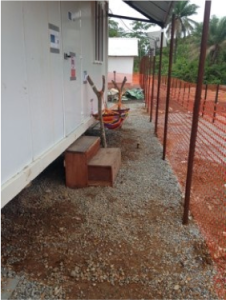Posted on behalf of Lauren
————————————————–
Since the 2nd of June I have been in Guinea contributing to the Ebola response by sequencing the new cases on the MinION. Many of you will be familiar with the project going on and will have heard about Josh Quick coming out to Conakry to set it up. I am here to continue his and Sophie Duraffour’s hard work.
Since Josh left, the sequencing lab has been relocated from Donka hospital in Conakry to its very own container on the outskirts of Coyah at an ETC (Ebola Treatment Centre) and adjacent to an EMLab (European Mobile Lab) doing diagnostics on delivered samples. This is essential to the process running smoothly as they immediately hand the positive RNA on to me once they have a PCR result and I can turn the sequencing around as quickly as possible, I then send the raw reads to Josh and Nick Loman back in the UK for them to run the analysis and send me back a tree. I then send out the tree to epidemiologists working on the chains of transmission and can either confirm or deny their suspicions on that particular transmission route. This all usually happens within 48 hours of me receiving the RNA.
I was out in Sierra Leone in December last year working in the diagnostic labs then right at the peak of the outbreak, so for me this is a huge advance in the fight against Ebola. I am seeing first hand epidemiologists being able to track transmission routes accurately with phylogenetic data in real time and then attempting to intercept the chain. This is exciting and could be the key to the end of this outbreak, although that is still probably a long way off.
Sequencing in the field is certainly not without its challenges;
- We have intermittent electricity supply so have to back everything up with UPS power to prevent a sequencing run failing just as it is starting, head torches are a godsend.
- Coordinating getting samples with other labs is difficult as are all logistical issues here.
- There is no running water in the house where we stay so cold bucket showers it is every morning.
- There are an annoying amount of flies and mosquitos everywhere as you will see from the picture below and I have very frustratingly got to the end of a library prep before only to witness a mosquito land directly in it before I could stop it.
- I have also had a 6cm long praying mantis land on my face during a critical pipetting stage so couldn’t move
- Unwelcome rodent lab assistants, that probably carry Lassa fever…
- The humidity has caused the magnets on my MagnaRack to come unstuck and I now have magnets flying all over the room towards metal whenever it is jolted, I am therefore probably more likely to die from a flying magnet right now than from Ebola
- The internet is absolutely appalling which makes responding to critical emails impossible, the upload of reads for Nick and Josh is a daily challenge that usually fills my swear jar to the top. The only thing that seems to work is whatsapp but that doesn’t have a MinION raw reads attachment button…
However, there are a huge amount of benefits to coming out to Guinea and being at the heart of the action;
- Again as you will see from the pictures below it is an absolutely stunning location and I get to enjoy that every morning on the ride into work
- Its great to get the opportunity to collaborate with epidemiologists and understand their processes in looking at chains of transmission and intercepting them.
- I hope that this project will be an example for future large scale outbreaks and the use of real time sequencing to help cut chains of transmission and understand the spread and evolution of a pathogen quickly. The portability and ease of setup of the MinION has enabled this here.
You can find the latest tree at ebola.nextflu.org and I’ll continue to sequence everyday to add to that so keep your beady eyes on it!









Out of curiosity, why don’t you assemble the raw reads and perform other analyses locally? Is it lack of hardware? Or are the analyses very customized (ie can’t be organized in to a workflows)?
Pingback: Links 6/22/15 | Mike the Mad Biologist